Motorcycle Racing On Ice! - Video
We don’t normally write dirtbike reviews at Motorcycle.com, as those are usually saved for our sister site, Off-Road.com. However, we’re going to make an exception for this 2013 Yamaha YZ450F converted for ice riding.
The reason we have this YZ is because fellow editor Tom Roderick and I entered ourselves in the Steel Shoe Fund 3-hour Endurance race held on a frozen Kettle Moraine Lake in Campbellsport, Wisconsin, which you can read about soon in a future story. And we were fortunate enough to have Yamaha step up and provide us with a potent weapon for this event.
An Introduction To The YZ450F
For those unfamiliar with the YZ450F, this is the third generation of the 450. For complete details, check out our review of the YZ from its launch in 2010. Its distinctive feature is the rearward slant of the highly oversquare (97.0 x 60.8mm) 449cc single-cylinder engine, helping with mass centralization. Also, air intake faces the front of the bike, while the exhaust has a straight path out the back, making for more efficient breathing at both ends of the motorcycle. Compression ratio is a lofty 12.5:1.
As the first Yamaha MXer with fuel injection, its ability to adapt to weather conditions is perfect for a frozen lakebed and frigid temperatures, saving the need to sort through a box of carburetor jets. In fact, the engine in our ice racer is completely stock, down to the “Tornado-style” exhaust and even the thermostat.
On the chassis side, forged and extruded aluminum comprise the frame, while a KYB fork and shock keep the tires to the ground. Our YZ retained these KYB units, but because a frozen lake is considerably more flat than a typical motocross track, both compression and rebound adjustments were slowed to suit the conditions.
Creating An Ice Racer
The biggest modification to the YZ is its tires. From a visual perspective, it’s easy to see the tires have screws in them. But it’s much more complicated than this.
Jeff Fredette, AMA hall of famer, multi-time ISDE medalist, and proprietor of Fredette Racing Products is the Yoda of the off-road and ice-racing world and is the man behind the ice tires for most, if not all, the racers who compete in the Midwest, including us. He starts with a Bridgestone ED77 front and Kenda V Groove ice tire in the rear. “I’ve tried virtually every combination out there, and this is the best,” Fredette says.
The tires are then aged for several months, sometimes years, in order to harden. Without this step, the grip from the screws and the torque from the engine would rip the tread blocks out of the soft tire. Once hardened, it’s time for the Gold Pro ice screws.
There are many types and variations of screws available, but to simplify the matter, only two are significant: AMA and Canadian screws. The latter are generally longer, with half the screw head cut off, essentially forming a chisel. Compared to the AMA’s shorter screw and complete head, “there’s no incentive to race against each other because the Canadian stuff is far better,” says Fredette.
The process for installing screws into dirtbike “knobbies” is quite intricate. First, the tire is lined with a used streetbike tire to give extra material for the screw to hold and prevent the screw from pulling out the tread block.
Fredette tells us old Harley tires make the best liners. “The guys at the local tire shops know me by now and are glad to get rid of them. Then I have an assistant cut off the sidewalls. That’s the only part of the process I don’t do myself.”
With liners in place, the tire is then placed in a custom jig, where the screws are then inserted by hand. “A rear [tire] can take up to 1143 screws,” Fredette says, depending on the tire and intended riding conditions. “Nowadays it takes me exactly an hour to install all of them. You can time me.”
But it’s not as simple as just inserting screws. The orientation — and even the tension — of each screw makes a huge difference. “There’s a bit of an art to it,” he says, noting how the slots and tension either grip the ice (edges) or allow it to slide (mid-section).
“I remember 30 years ago guys would try and do it themselves. Now, people realize it’s not that simple and just pay me to do it.” When all is said and done, a complete set of tires can run close to $800. Fredette estimates a complete set weighs about 50 pounds.
After tires, the modifications are few and safety related. Extended fenders ($54.95/ea.) front and rear from Fredette Racing Products protect riders in the event of a crash, and fleece-lined handlebar gauntlets ($18.95) from Moose Utility Division help protect hands from the cold air.
AMA Hall of Famer Jeff Fredette Takes To the IceJeff Fredette, the man behind Fredette Racing Products, is more than just a business owner and slinger of motorcycle ice tires. He’s been competing on the national, and international, stage for more than 40 years, notching numerous victories — and induction into the AMA Hall of Fame — along the way.
Best known for his string of International Six Days Enduro starts — 31 to date, finishing each one and nabbing 10 gold medals in the process — Fredette is a legend in the off-road world. The ISDE is a grueling competition, testing both man and machine, but as life achievements go, his experiences here top the list. “I’ve met so many great people and been able to experience life around the world.”
During the winter off season Fredette enjoys ice racing. “It’s a good way to stay sharp on two wheels during the long winter months here in the Midwest. It keeps you in shape and helps build endurance. Then when riding season comes again, you’re ready to go.”
One special moment Fredette looks back on was the 2000 “Numb Bum” 24-hour ice race in Canada. “I was teamed up with Dick Burleson, Scotty Parker, Mike Bell and Kevin Schwantz. Great riders, but most had never been on ice. After 24 hours of racing, it came down to the last lap and we won by just three seconds!”
Lately, the demands of his business limit the time he has to ride. During the Steel Shoe 3-hour race last year, the engine cases on his machine split, forcing him to retire. That night, he wheeled the bike to a corner of his shop.
On the heels of the 2013 race “I dusted the bike off Thursday, JB Weld the cases back together Friday, kickstarted it to make sure it worked, then didn’t touch it again until the race on Sunday.” He finished third overall and handily won the Ironman class, for competitors who complete the entire race solo.
Despite all his success, Fredette remains a humble, personable character, with few regrets. “You can’t really look back and wonder ‘what if?’ We only get one lap in life and we have to make the most of it. So far, I like the lap I’m on.” As for retirement, he’s showing no signs of slowing down. “I still love riding and competing,” he says. “As long as I’ve still got that, I don’t plan on retiring any time soon.”
The Ride
Riding the YZ450 ice bike is much like a supermoto – the riding position, technique and sensations are all the same. I found the cold conditions can sometimes prove challenging when trying to kickstart the bike, but the fuel injection is otherwise flawless.
The 39.4-inch seat height didn’t make it easy for my 30-inch inseam to touch the ground or swing a leg over with all my underlayers, but ride height wasn’t lowered in order to maintain ground clearance. And yes, the bike can lean over pretty far.
Right from the start, throttle response is crisp and well metered. The 450cc Single has loads of punch, aided in part by the 47-tooth rear sprocket, up one from the stock 46-tooth. All this torque makes it easy to get lazy with shifts, as there’s enough grunt to pull out of most situations.
Typical for a motocross engine, the YZ runs out of steam up top, but it rarely sees high revs for long, as the plentiful low- and mid-range squirts the bike from one turn to the next. Approaching turns, the stock 250mm single front brake disc does an adequate job of slowing the bike, with impressive feel at the lever allowing the rider to trailbrake to the apex.
At this point, with the bike fully leaned, the tires perform their best. Unlike any other form of riding, a healthy whack of the throttle is encouraged when exiting corners and results in forceful forward motion as the screws dig into the ice. And despite the 50-pounds worth of tires, throwing the Yamaha from side to side isn’t a laborious effort.
On the flat ice, the suspension doesn’t have much to do other than keep the bike composed under braking. However, when ruts form on the racing line, the slower damping made it difficult to stay on-line. The stiff setup resulted in the YZ bouncing over the grooves and pushing the bike wide. That said, more skilled riders we saw didn’t have problems staying in line, so chalk it up to our inexperience.
Minor suspension woes aside, the Yamaha YZ450F makes a fine ice companion. Compared to the YZ250F we also had on hand, the torque-filled 450cc engine was much easier to ride, as attention could focus on learning the technique of riding on ice rather than our attention being diverted to worrying about gear shifts.
The traction from the spiked tires is impressive, enabling remarkable lean angles in the corners. But, as you’ll see from the pictures, both Tom and I just grazed the surface of the YZ’s performance capabilities.
So, how quickly would we adapt to racing a motocross bike on a sheet of ice? We’d soon find out in the three-hour endurance race. Look for that story soon.
Related Reading
Inside The 2013 Supercross Works Bikes
2010 Yamaha YZ450F Review
2010 Kawasaki KX450F Review
Yamaha Sketches Out The Features On The New 2010 YZ450F - Video
2010 Yamaha YZ450F Preview
More by Troy Siahaan




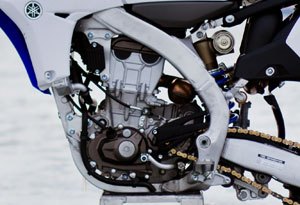










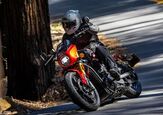
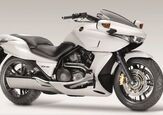
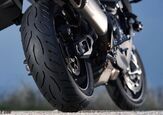
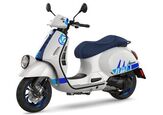
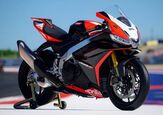
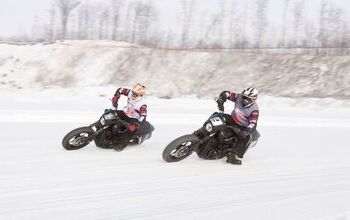

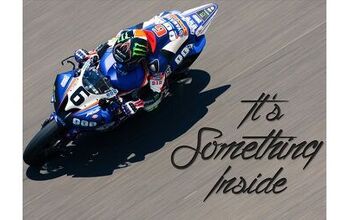

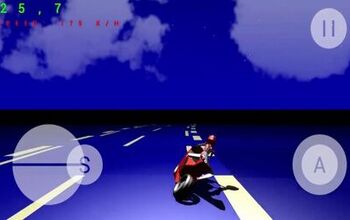
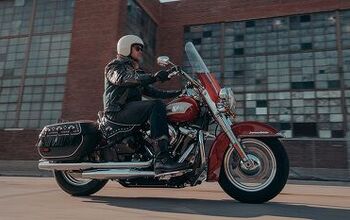

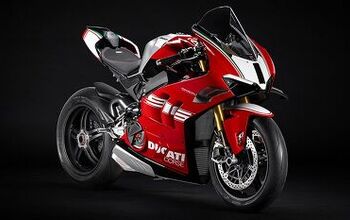
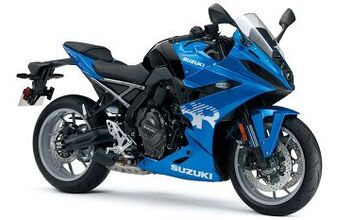


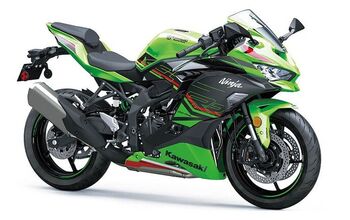
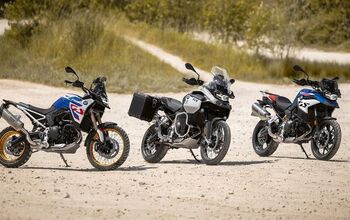

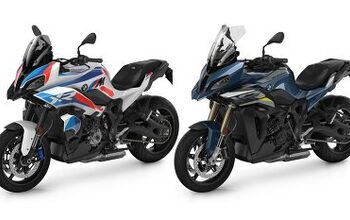
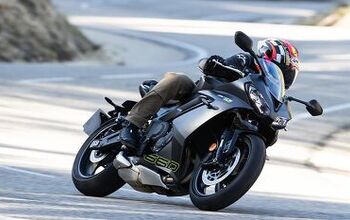
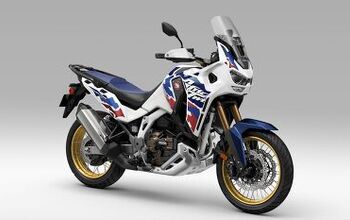
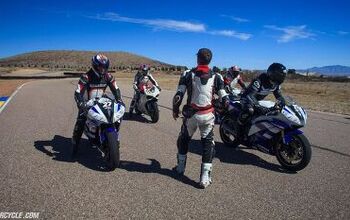
Comments
Join the conversation